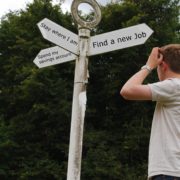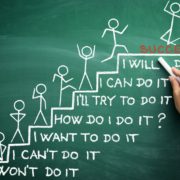Close Your Eyes and Visualize
[guestpost]This is a guest post by Amy Collinsworth who works at Boston University as the Student Outreach Manager for the Center for Career Development and the Educational Resource Center. She holds a bachelor of arts in marketing from Rockford University and a master of science in college student personnel from the University of Tennessee. Amy’s professional background includes working in MBA career management and undergraduate student leadership development. You can connect with her at @AmyCollinsworth[/guestpost]
“Today we will drive to the parking lot at your school, and by using the tool we learned about in the Tony Robbins recording*, you will make the basketball into the basket on your first shot!” dad said. I was not sure what to expect as we drove to the parking lot at Thompson Elementary that breezy spring afternoon, but I was certain my petite 4-foot-tall frame and poor hand-eye coordination would be my down-fall in making the basket. I got out of the car and walked to the hoop, carefully positioning myself a few feet in front of the hoop on the center of the faded white spray painted line.
I took a deep breath and closed my eyes.
“Now, before you throw the ball, keep your eyes closed and picture yourself making the basketball into the hoop on the first try,” dad said.
While holding the basketball in front of me, I took a moment to gather my thoughts and visualize making the basket. My thoughts transcended all of my 10-year-old worries and I focused on being present and fulfilling my goal. As the elementary school kid who spent many gym classes making failed attempts to throw the basketball into the hoop, spending more time running after the ball than hearing that crisp “swish” as the ball went through the net, this was a regular challenge I faced. I was determined to use this new tool to reach my goal.
I opened my eyes.
And it happened. I made it happen.
It felt like magic.
This experience is one of the most memorable moments of my childhood. Embedded within this lesson about the power of visualization is also the idea that where there’s a will, there’s a way. If you have the will and can visualize yourself accomplishing a goal, it can and will happen. It was not until many years later when I was in college that I began to appreciate how much visualization has played out in my life. As the years have passed since that day in the parking lot and I have set goals to get into college, study abroad, hold leadership roles, travel, become a better friend, go to graduate school, and get a full-time job, visualization has become intrinsic to the process of setting and achieving all of my major life goals.
There are a few key steps to take after setting a goal to use visualization to achieve the goal:
1) Clear Your Mind
Effective visualization can only happen if you can clear your mind and really focus on your goal. [Tweet This]
Practicing this type of focus is also helpful with developing the skill of compartmentalization, but that is a topic for another blog post.
It can also be helpful to find a physical space where you are able to be calm, center yourself, and think without distraction (yes, that means sans-technology). Separate your thoughts from everything else going on in your life and think about why you have set this goal and how it will improve your life.
2) Picture It Happening
You have decided to set a new goal for yourself. Great! Now what? Once you set a goal and before you determine HOW you will achieve the goal, take a moment to close your eyes and envision yourself in achievement-mode.
How will you feel when you have accomplished your goal? Do you foresee yourself having grown and developed as a result of the work you put in to achieving the goal? Have you positively affected others’ lives? Have you gained new friends, mentors, and teachers along the way?
Taking time to visualize your goal “happening” will help you build confidence before you set out on the journey toward achieving your goal. [Tweet This]
3) Phone a Friend
You are convinced this is the right path for you, but can others see you accomplishing this goal? I have found throughout the many years I have used visualization that an important part of setting new goals is “trying them out” on your closest friends and family.
By talking through new goals and describing the visions you have of yourself accomplishing a goal, close friends and family will often share valuable perspectives with you that will enhance your journey toward goal-achievement.
Start to ask friends what they think about your new goal. They may say, “Wow! That is so YOU! This really makes sense for you.” This type of response can really boost self-esteem and jump-start your journey to making it happen. Oppositely, they may not share a perspective that this goal makes sense for you and may even provide critical feedback.
Absorb the feedback and consider the questions they have posed. Dig a little deeper with some questions about why they do not share your vision.
This does not necessarily mean you should change your goal, but considering the support as well as the criticisms you receive is important to solidifying your vision before you begin to take the next steps toward achieving your goal: creating your timeline of to-do’s (think micro-to-macro planning) and tackling your first identified task.
Conclusion
The journey toward goal achievement is often filled with frustrating detours that can make what initially seems like a quick, traffic-free trip down the highway seem like a trip that will never end.
Sometimes you may even feel like you want to turn around and go back home before arriving at your destination.
The most important thing to remember when using visualization is that creating a mental picture of what it will be like to achieve the goal is what will keep you going when you have no idea how the detour will lead you back to achieving your goal.
Once you experience the power of visualization, you will never forget the confidence and feeling of accomplishment you gain from using this tool.
____________________________
*Awaken the Giant Within
If you have used visualization in your process of setting and achieving goals, what steps have you found to be successful in implementing visualization?
If you have not used visualization, but want to implement it with your next goal, please share your goal and a few sentences about what you visualize when you think about accomplishing the goal.











I agree 100%. I wrote a book on . I invite you to look into it and share. Visualize Yourself: Designing the Outcome if Your Life: One Issue at a Time. It can be found anywhere online as an ebook or in paperback.
Continue visualizing!
Sincerely, Aileen Nealie, LMFT, DCEP
Aileen, thanks for sharing. What is one of the tips from your book?
Hi Aileen! Thanks for the comment– visualization is probably one of the best skills I’ve learned to incorporate into daily life. I’m with Chris– I’d love to know a tip you share in your book!
-Amy
With Visualize Yourself Aileen Nealie helps us remember the power of our imaginations and helps us make practical use of our daydreaming. In this book she has compiled many original, creative and easy to use visualization pieces which are divided into all different themes of life. From day to day issues, to relationship difficulties, to mental health issues, to infertility, to issues related to children; this book can be utilized to help us overcome whatever our struggles might be. Aileen Nealie will walk us through all the basic steps to learn to visualize and to master this innate skill to our benefit. She says: “You can mold any visualization piece and make it your own. Visualize Yourself gives you the tools to design your life, one issue at a time” “Who says life has to be difficult? Well, adults do. Who has proven that life flows and is easy? Well, children have. How do you want to lead your life? Well, you decide. With this book I am attempting to help you remember the easy way. I hope you choose this route. Dare to come out of your shell and play in the magical kingdom to create YOUR real world.”
I heart tony Robbins and visualization. Great post Amy!
Amy, how do you use it in your life?